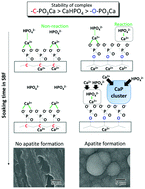当前位置:
X-MOL 学术
›
J. Mater. Chem. B
›
论文详情
Our official English website, www.x-mol.net, welcomes your feedback! (Note: you will need to create a separate account there.)
Structural effects of phosphate groups on apatite formation in a copolymer modified with Ca2+ in a simulated body fluid
Journal of Materials Chemistry B ( IF 7 ) Pub Date : 2017-12-05 00:00:00 , DOI: 10.1039/c7tb02363d Ryo Hamai 1, 2, 3 , Hirotaka Maeda 3, 4, 5 , Hikaru Sawai 3, 3, 6, 7, 8 , Yuki Shirosaki 2, 3, 9 , Toshihiro Kasuga 3, 4, 5 , Toshiki Miyazaki 1, 2, 3
Journal of Materials Chemistry B ( IF 7 ) Pub Date : 2017-12-05 00:00:00 , DOI: 10.1039/c7tb02363d Ryo Hamai 1, 2, 3 , Hirotaka Maeda 3, 4, 5 , Hikaru Sawai 3, 3, 6, 7, 8 , Yuki Shirosaki 2, 3, 9 , Toshihiro Kasuga 3, 4, 5 , Toshiki Miyazaki 1, 2, 3
Affiliation

|
Organic–inorganic composites are novel bone substitutes that can ameliorate the mismatch of Young's moduli between natural bone and implanted ceramics. Phosphate groups contribute to the formation of apatite in a simulated body fluid (SBF) and the adhesion of osteoblast-like cells. Therefore, modification of a polymer with these functional groups is expected to enhance the ability of the organic–inorganic composite to bond with bone. Two phosphate groups have been used, phosphonic acid (–C–PO3H2) and phosphoric acid (–O–PO3H2). However, the effects of structural differences between these phosphate groups have not been clarified. In this study, the apatite formation of copolymers modified with Ca2+ and either –C–PO3H2 or –O–PO3H2 was examined. The mechanism of apatite formation is discussed based on analytical and computational approaches. The copolymers containing –O–PO3H2, but not those containing –C–PO3H2, formed apatite in the SBF, although both released similar amounts of Ca2+ into the SBF. Adsorption of HPO42− from –O–PO3H2 in the SBF following Ca2+ adsorption was confirmed by zeta-potential measurement and X-ray photoelectron spectroscopy. The measurement of the complex formation constant revealed that the –O–PO32−⋯Ca2+ complex was thermodynamically unstable enough to convert into CaHPO4, which was not the case with –C–PO32−⋯Ca2+. The formation of CaHPO4-based clusters was found to be a key factor for apatite nucleation. In conclusion, this study revealed that modification with –O–PO3H2 was more effective for enhancing apatite formation compared with –C–PO3H2.
中文翻译:

磷酸根基团对模拟体液中 Ca 2+改性的共聚物中磷灰石形成的结构影响
有机-无机复合材料是新颖的骨骼替代品,可以改善天然骨骼与植入陶瓷之间的杨氏模量不匹配。磷酸盐基团有助于模拟体液(SBF)中磷灰石的形成以及成骨细胞样细胞的粘附。因此,用这些官能团修饰聚合物有望增强有机-无机复合材料与骨骼结合的能力。使用了两个磷酸基团,膦酸(–C–PO 3 H 2)和磷酸(–O–PO 3 H 2)。然而,这些磷酸盐基团之间的结构差异的影响尚未阐明。在这项研究中,Ca 2+改性的共聚物的磷灰石形成并检查了–C–PO 3 H 2或–O–PO 3 H 2。基于分析和计算方法,讨论了磷灰石形成的机理。含有–O–PO 3 H 2的共聚物,但不含–C–PO 3 H 2的共聚物,在SBF中形成了磷灰石,尽管两者都向SBF中释放了相似量的Ca 2+。Ca 2+对SBF中–O–PO 3 H 2的HPO 4 2-的吸附通过ζ电势测量和X射线光电子能谱确认了吸附。络合物形成常数的测量结果表明,–O–PO 3 2− ⋯Ca 2+络合物在热力学上不稳定,足以转化为CaHPO 4,–C–PO 3 2− ⋯Ca 2+则不是这种情况。发现基于CaHPO 4的团簇的形成是磷灰石成核的关键因素。总之,这项研究表明,与–C–PO 3 H 2相比,–O–PO 3 H 2修饰对增强磷灰石形成更有效。
更新日期:2017-12-05
中文翻译:

磷酸根基团对模拟体液中 Ca 2+改性的共聚物中磷灰石形成的结构影响
有机-无机复合材料是新颖的骨骼替代品,可以改善天然骨骼与植入陶瓷之间的杨氏模量不匹配。磷酸盐基团有助于模拟体液(SBF)中磷灰石的形成以及成骨细胞样细胞的粘附。因此,用这些官能团修饰聚合物有望增强有机-无机复合材料与骨骼结合的能力。使用了两个磷酸基团,膦酸(–C–PO 3 H 2)和磷酸(–O–PO 3 H 2)。然而,这些磷酸盐基团之间的结构差异的影响尚未阐明。在这项研究中,Ca 2+改性的共聚物的磷灰石形成并检查了–C–PO 3 H 2或–O–PO 3 H 2。基于分析和计算方法,讨论了磷灰石形成的机理。含有–O–PO 3 H 2的共聚物,但不含–C–PO 3 H 2的共聚物,在SBF中形成了磷灰石,尽管两者都向SBF中释放了相似量的Ca 2+。Ca 2+对SBF中–O–PO 3 H 2的HPO 4 2-的吸附通过ζ电势测量和X射线光电子能谱确认了吸附。络合物形成常数的测量结果表明,–O–PO 3 2− ⋯Ca 2+络合物在热力学上不稳定,足以转化为CaHPO 4,–C–PO 3 2− ⋯Ca 2+则不是这种情况。发现基于CaHPO 4的团簇的形成是磷灰石成核的关键因素。总之,这项研究表明,与–C–PO 3 H 2相比,–O–PO 3 H 2修饰对增强磷灰石形成更有效。



























 京公网安备 11010802027423号
京公网安备 11010802027423号